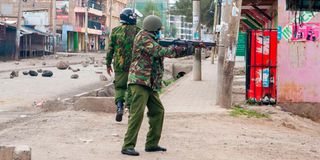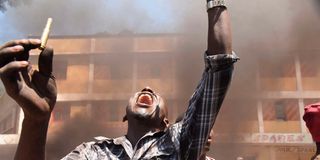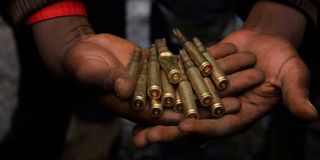Explainer: Why a gunshot on the leg can be fatal

A police officer aims his gun at protesters along Old Namanga road in Kitengela during Saba Saba protests on July 7, 2025.
President William Ruto’s directive instructing police to specifically shoot protesters in the leg—ensuring the limb is broken to necessitate hospitalisation—is dangerous and could cause permanent bodily damage, medical experts have warned.
This comes about two weeks after Hussein Khalid, a Kenyan human rights activist and lawyer currently serving as the CEO of VOCAL Africa, announced on X (formerly Twitter) that 23-year-old Reagan Omondi had succumbed to injuries after being shot in the hand and leg by police during the June 25, 2025, Gen Z protests.
“Our team is presently at City Mortuary following up on yet another victim of the June 25 protests. 23-year-old Reagan Omondi was shot in the hand and leg in the evening and was rushed to Kibera Level 4 Hospital, where he remained under treatment until he succumbed to his injuries around midnight. Reagan's death brings the number of those killed in the Nairobi protests to six,” Khalid said.
Speaking to the Nation, consultant orthopaedic trauma surgeon at The Nairobi West Hospital, Dr Alihussein Tarwadi, explained that gunshot wounds to the leg can lead to a wide range of life-threatening and permanently disabling complications.
Dr Tarwadi, who also treats injured Kenya Defence Forces (KDF) officers and police officers at the facility, a preferred health facility for security personnel, explained that gunshot wounds are high-velocity injuries caused by either low- or high-velocity bullets.
“A low-velocity bullet has a speed of 300–900 m/s and causes tissue disruption three to six times the diameter of the bullet, while a high-velocity bullet exceeds 900 m/s and causes tissue damage up to 30–40 times the bullet’s diameter,” he said.
“When a bullet goes through clothing such as jeans, it carries with it dirt and bacteria, leading to a high risk of infection.”

Man crosses his legs.
Dr Tarwadi explained that complications from such wounds depend on various factors, including the caliber of the weapon, the direction of the bullet’s entry, proximity to the shooter and whether bones, major blood vessels or nerves are involved. These complications can be immediate, early, or late.
Hemorrhage
Among the immediate complications he listed is also hemorrhage. He explains that bleeding can be internal or external.
“Excessive bleeding can send a patient into shock, and if not treated immediately, it may lead to organ failure and death,” he said.
He also cited nerve injury, saying damage to major nerves may cause limb paralysis, while damage to smaller nerves can cause numbness.

A protesting youth holds a spent bullet cartridge as he shouts during an anti-government protests.
There is also vascular injury, as damage to blood vessels can lead to amputation.
There is also the risk of fractures, where bones shattered by bullets may require complex surgical fixation.
“We also have compartment syndrome. This is increased pressure within the leg due to internal bleeding or swelling, and if not urgently treated with surgery to relieve the pressure, the limb can ‘die’ due to blocked blood flow,” he explained.
For early complications, which may appear within hours or days, Dr Tarwadi cited:
- Infection: Particularly in open wounds, which, if severe and untreated, can cause septic shock and death.
- Thrombosis or embolism: Blood clots may form in damaged vessels, potentially traveling to the lungs and causing fatal respiratory complications.
- Wound healing issues: Some patients experience prolonged healing or complications at the site of injury.
Chronic pain
As for long-term and potentially permanent complications, Dr Tarwadi warned of: Chronic pain or neuropathy due to nerve damage, Improper bone healing, leading to deformity or loss of function, scarring and contractures, limb shortening due to bone loss, which may require surgical correction.
Post-traumatic arthritis, especially if a joint was involved, psychological impact, including PTSD, anxiety, or depression.
“If it is also a lead bullet, lead poisoning significantly affects the patient and can even be fatal,” he added.
Dr Tarwadi’s assertions are supported by a peer-reviewed study published in the Australasian Emergency Nursing Journal, which found that gunshot wounds to the leg can lead to severe neurovascular complications.

A protester displays spent cartridges used by police to disperse anti-government protesters in Karatina town, Nyeri County on July 16, 2024.
“Gunshot wounds cause significant damage to body tissues. Between 1995 and 2005, GSWs were the second leading cause of homicides in New South Wales after stabbings, due to their high velocity and potential for multiple complications including bony, vascular, and nerve injuries, soft tissue destruction, compartment syndrome, delayed healing, infection, and psychosocial trauma,” the study noted.
The researchers also explained the concept of “cavitation”, a key factor in GSW-related damage. Cavitation refers to the displacement of cells when energy from a bullet is transferred into the body. This can be:
- Permanent cavitation: Tissue is crushed, leaving a lasting cavity.
- Temporary cavitation: Tissue stretches and may return to normal, but often results in damage.
The extent of tissue damage also depends on bullet profile, including:
- Yaw: Deviation of the bullet’s nose upon impact,
- Tumble: Rotation or somersaulting of the bullet in tissue, increasing the damage radius.
- Fragmentation: When a bullet breaks apart on impact, spreading fragments over a wider area and causing more extensive damage.
Dangerous
Dr Chege Mwangi, an orthopaedic and spine surgeon at Kenai Orthopaedic and Spine Centre's answers reveal just how medically serious, and potentially deadly, a leg wound can be.
“Yes, it is very dangerous when one is shot in the leg,” he begins. “One can die from such an injury because the bullet can penetrate through the big blood vessels. You can bleed out entirely from a leg wound.”
Dr Mwangi says a bullet can rupture the femoral artery, a major blood vessel in the thigh. Once severed, the injured person can go into shock and die within minutes from massive blood loss, what doctors call hemorrhagic shock.
But death doesn't always come instantly.
“There’s what can cause death immediately,” Dr Mwangi explains, “and there’s what can cause death after 72 or so hours.”
Infections that creep in if wounds are not cleaned and treated in time can be just as fatal, he says.
“If the leg is not washed in the theatre properly, and the bone and tissue aren’t treated, infection can spread throughout the body and lead to death.”
Even if a patient survives, the recovery journey is long and painful. Some victims may lose their leg entirely.
“If the blood vessel is injured severely and can’t be repaired, blood flow to the lower part of the leg stops. That will lead to amputation,” he says.
“There are also cases where massive soft tissue, muscles, or skin is lost—then we have no choice but to amputate.”
Dr Mwangi strongly cautions against the idea of any so-called "safe spot" to shoot someone in the leg.
“We cannot say there is a place that is safe to be shot in the leg,” he clarifies. “Yes, the femoral artery runs along the inner thigh, so an outer wound might miss it. But bullets are unpredictable. We should not be advocating for shooting anyone, anywhere.”
Once a person is shot, time is critical.
“They must get help immediately. Even just wrapping the wound with a cloth and stabilising the leg can buy time. But ideally, they need to be rushed to the hospital for surgery to stop the bleeding and clean the wound.”
Doctors also worry about complications like blood clots and pulmonary embolism (clots that travel to the lungs), especially if the patient is bedridden for long.
“That’s why we administer anticoagulants early to prevent blood clots,” Dr Mwangi explains.
He adds that gunshot injuries are often more severe than they appear at first glance. Even a small entry wound could mask massive internal destruction, based on the energy dissipated into the leg. Surgeons use something called the Gustilo-Anderson Classification to determine the severity of open fractures gunshot wounds usually land in the most serious category: Type III.
Behind the sterile walls of operating theatres and ICUs, the real impact of "just shoot the leg" plays out in shattered bones, lost limbs, and bodies fighting infection or blood loss.
For surgeons like Dr Mwangi, it’s not a hypothetical.
“Shooting someone in the leg can absolutely kill them,” he says. “And even if it doesn’t, it can change their life forever.”



